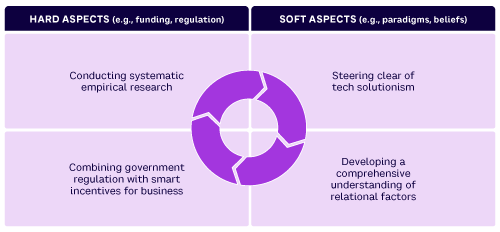Contributors: Devin Diran, Francesca Ciulli, and Albert Meijer
The importance of linking the green and digital transitions is undisputed. However, while both will transform our societies and economies, they are very different in nature and dynamics. This requires understanding the “twin transition” as a new phenomenon.
The European Commission has shown clear strategic direction and ambitious leadership by acknowledging that these two trends will shape Europe and its future. But the simultaneous pursuit of digital and green transitions raises questions for industry and government institutions alike. How can we steer the twin transition in the desired direction while avoiding recognized risks? How can we ensure that digital and green initiatives support and enhance each other rather than working against one another? What policies can simultaneously promote digital innovation and environmental sustainability?
One thing is certain: a just transition is crucial for widespread acceptance of green-digital solutions. Ensuring that the twin transition proceeds in a fair, equitable manner hinges on a holistic understanding of its dynamics, including opportunities, pitfalls, and remaining uncertainties.
We propose four priority areas that managers and policymakers should consider as they work to understand and advance the twin transition. Our ideas are based on a joint session with researchers, policymakers, and practitioners at the first annual symposium of the Special Interest Group on Digitalization and AI for Sustainability (DAISY), hosted by the Copernicus Institute of Sustainable Development, Utrecht University, the Netherlands.
During the session, we had a unique opportunity to explore the interplay between the green and digital transitions, discuss drivers and concerns, and gather expert advice on how it may be possible to align the transitions. Based on this, we identified four priority areas for better understanding and advancing the twin transition (see Figure 1):
-
Conducting systematic empirical research to inform data standardization efforts and overcome the problems associated with data fragmentation (e.g., operational inefficiencies and security risks)
-
Steering clear of “tech solutionism” and exploring areas where little or no technology use can be beneficial
-
Developing a comprehensive understanding of the relational factors at play in the twin transition (e.g., power imbalances, fairness)
-
Combining government regulation with smart incentives for business in a well-rounded twin transition policy
These four areas are in line with the EU’s call for a proactive and integrated management of social, technological, environmental, economic, and political domains in twin transition. We believe the connections between “hard” and “soft” aspects, such as funding research on new technologies while considering alternatives to tech solutionism and fostering social innovation, are especially important. By combining hard and soft aspects, managers and policymakers (as well as researchers and civil society) can champion a comprehensive, multidimensional approach that leverages the strengths of various stakeholders and helps the twin transition proceed in a fair and equitable way.

[For more from the authors on this topic, see: “4 Priorities for Advancing the Twin Transition.”]





